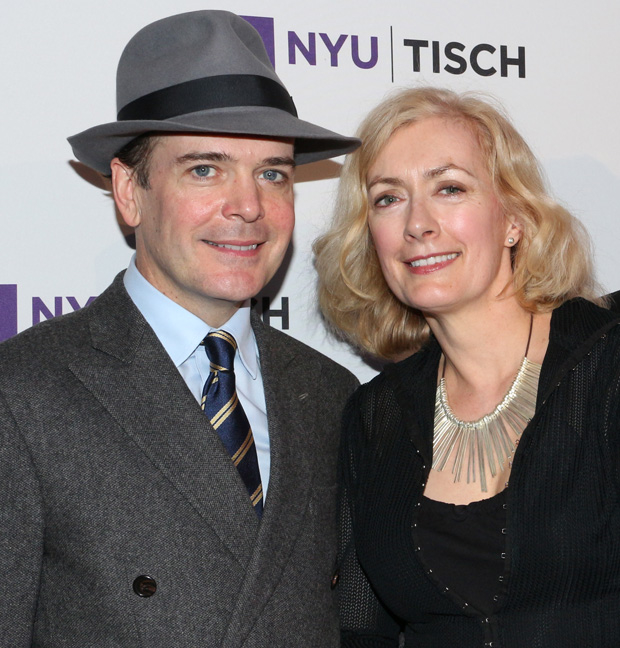A Bathtub Phone Call With Jefferson Mays, Star of a Solo Christmas Carol
Jefferson Mays was wet, to begin with. There is no doubt whatever about that. The register of his saturation was admitted to by Mays himself. Mays signed it: and Mays's name was good upon 'Change, for anything he chose to put his hand to. Old Mays was as wet as any man doing an interview in a bathtub.
Mays knew he was in the bath? Of course he did. How could it be otherwise? Mays admitted to it himself, before the phone cut out and forced him to remove himself from this water-based exchange on a journey into another part of his home where the connection would be clearer.
The mention of Mays's bath brings me back to the point I started from. This must be distinctly understood, or nothing wonderful can come of the story I am going to relate. If we were not perfectly convinced that Mays was in rehearsals for his one-man production of Charles Dickens's A Christmas Carol at the Geffen Playhouse in Los Angeles before this interview began, there would be nothing remarkable in his taking a bath during the day.
But knowing that he had rehearsals ahead of him before previews begin on November 1, there is no doubt that Mays was in the bathtub preparing for a full day of reciting sentences constructed in this manner.

(© David Gordon)
Tell me about your relationship to A Christmas Carol.
I have a distinct memory of it being read aloud to me by my parents. It was, appropriately enough, a cold winter's evening and I remember the family basset hound came running out of the kitchen and got caught up in the power cord of the black-and-white portable television set that was sitting on the table in the living room. It fell and smashed to the floor. With the evening's entertainment lying in ruins, my father plunked down a yellowing volume of Charles Dickens, opened it to stave 1 of A Christmas Carol, and began reading.
My parents, passing the volume back and forth between them by the fireside, read through the entire unexpurgated story. As children, we were transfixed by it. It wasn't just an introduction to A Christmas Carol; it was an introduction to the theater, reduced to its basic equation of audience, performers, and a cracking good story. It became a bit of a family tradition.
When you have a text that's so well known, not to mention very frequently adapted, where do you begin to create a solo edition?
The person who invented the one-man version was Charles Dickens himself. The New York Public Library has a copy of his own prompt book, in which he cut out every page of the complete first edition manuscript, pasted it into a notebook, and then went through it several times and edited it, very brutally. So we began with his own performance text, and then we made some further cuts in it and some restorations of things that he dispensed, to make our own unique version. Something that's often missed when it's adapted for the stage is Dickens's own wonderful narrative voice. It's a voice full of wit, observation, poetry, and social outrage. I'm hoping to get back to that.
How similar is this experience to playing multiple characters in I Am My Own Wife and Gentleman's Guide?
I suppose it's similar, but it feels entirely different. They're not so much character transformations. It's like a river of narrative flowing, and then every so often, a body will come floating down for a few seconds and then disappear. I guess it's closer to I Am My Own Wife by default; the one person is there onstage in one set of clothes telling this story. It's also less fragmented than I Am My Own Wife. That was a story told from different points of view by various characters. The unifying narrative holds this together.
As writer and performer, are there things you realized you needed in the text only as you started performing it? Or things you recognized you could lose?
Absolutely. Something is quite different on the page than it is when you get up on your feet. I want the greatest memory of this piece to be an image that's fashioned in the imagination of the audience. Can I create it with words alone? That was a governing principle of mine. We're trying to find a relationship between the word and the image, and the word and the action. Going through it with that in mind, you constantly have to ask yourself what's necessary.
Does working on this piece take you back to your childhood?
Yes. This is probably the most deeply emotional thing I've ever done. Some of my parents' line readings and characterizations have inevitably crept into it and I'm trying to embrace that and navigate this difficult territory. But I am in love with this story. I think it's the greatest secular humanist text there is. I think now, most importantly, it's useful to be reminded of things like "what is a good life" and the importance of friendship and family, and mercy and charity and forbearance — all of these virtues that seem to be slipping away.

(© David Gordon)










